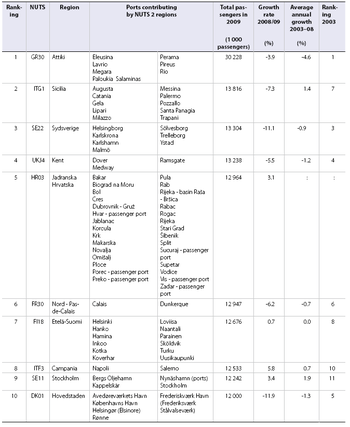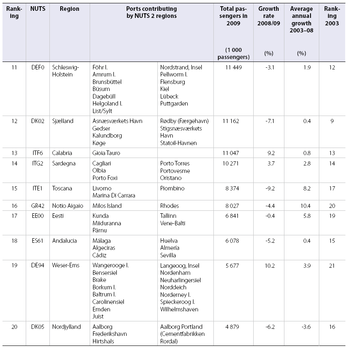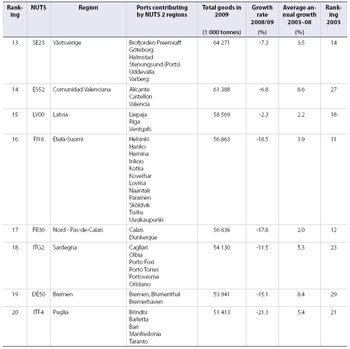Archive:Maritime transport statistics at regional level
This Statistics Explained article is outdated and has been archived - for recent articles on transport see here.
- Data from March 2011. Most recent data: Further Eurostat information, Main tables and Database.
This article on maritime transport focuses on the total number of passengers and the total number of tonnes loaded and unloaded in NUTS 2 regions in the European Union EU.
Tables 1 and 2 show the top-20 regions with the highest number of sea passengers and highest volume of sea freight in 2009.




Main statistical findings
The number of passengers embarking or disembarking in EU ports fell slightly (– 2.2 %) in 2009, after remaining stable over the previous five-year period. However, the volume of freight handled in EU ports dropped by 12.5 % in 2009, after growing by more than 13 % over the previous five-year period. Despite this fall, maritime transport plays an important role in transporting goods in extra-EU trade. The geographical spread of the main European seaports illustrates the flexibility of maritime transport, allowing large volumes to be loaded and unloaded close to the main recipients and producers. Landlocked Member States (Czech Republic, Luxembourg, Hungary, Austria and Slovakia) are not active in this sector.
Eurostat’s databases contain regional maritime transport statistics on passengers and freight. They show passenger and freight movements by NUTS 2 region, measured in thousand passengers and tonnes. Passenger data are divided into passengers embarking and disembarking. Freight statistics are divided into tonnes of freight loaded and unloaded. Two series are available on maritime passenger transport, based on different methods. One series started in 1997 and ended in 2003 and was replaced by a new time series with different definitions in 2004 (now excluding passengers on cruises).
Currently, data on maritime transport are collected under Directive 2009/42 on statistical returns in respect of carriage of goods and passengers by sea. This directive provides detailed quarterly data for ports handling more than 1 million tonnes of goods or recording more than 200 000 passenger movements a year. The data collected at port level are then aggregated at NUTS 2 regional level.
This section on maritime transport focuses on the total number of passengers and the total number of tonnes loaded and unloaded in NUTS 2 regions in Europe. Tables 3 and 4 show the top 20 regions with the highest number of sea passengers and highest volume of sea freight in 2009.
Unsurprisingly, maritime passenger transport is dominated by regions with a sea-faring tradition. By far the largest number of passengers transported by sea (30.2 million) is recorded by the Attiki region, where the port of Piraeus is the main gateway for passengers to the Greek islands. The second highest number of passengers was recorded in Sicilia, with 13.8 million passengers; Sicilia services several ferry connections to the mainland of Italy, as well as ferry routes to Malta and Tunisia. The ports of the Sydsverige region in Sweden, counting 13.3 million passenger movements in 2009, service a large number of ferry connections to the other countries around the Baltic Sea. The high passenger counts in Kent (13.2 million) and Nord- Pas-de-Calais (12.9 million) reflect the close ties across the English Channel, with the ports of Dover, Medway and Ramsgate on the English side and Calais and Dunkerque on the French side.
As in previous years, the rise in passenger numbers from 2008 to 2009 varied greatly between the top 20 European regions in terms of maritime passenger transport. In 13 of the 20 top regions, passenger numbers fell, but they increased in the other seven regions. The largest region in terms of maritime passenger transport, Attiki, continued the negative trend seen over the previous five years, with a 3.9 % fall in passenger numbers from 2008 to 2009. The other top regions also recorded declines: Sicilia (– 7.3 %), Sydsverige (– 11.1 %) and Kent (– 5.5 %). By contrast, the Weser-Ems region with its connections to the East Frisian Islands recorded a 10.2% increase from 2008 to 2009, continuing the increase over the previous five-year period. Other regions with notable increases in maritime passenger numbers included Calabria (9.2 %) and Campania (5.8 %).
For maritime freight, Zuid-Holland in the Netherlands with the port of Rotterdam is in the lead by far. It handled 349 million tonnes of freight in 2009, more than twice the volume of the second of the top 20 European regions, Antwerpen in Belgium (142 million tonnes). These two regions were followed by Hamburg in Germany (95 million tonnes) and Haute Normandie (Dieppe, Le Havre, Rouen) in France (92 million tonnes). These volumes are far higher than those recorded for other modes of transport and illustrate the key role maritime freight plays in the European economy. Maritime transport is characterised by high flexibility, allowing large volumes to be loaded and unloaded close to the main recipients and producers.
From 2008 to 2009, freight volumes fell in all but one of the top 20 regions in terms of maritime freight handled. In nine regions, it fell by more than 15 %. Nevertheless, the magnitude of the decline reflects to a varying extent the global economic crisis and associated fall in international trade from 2008 to 2009. Amongst the top 20 regions, the most dramatic decreases were seen in Puglia in Italy (– 21.3 %) and Hamburg in Germany (– 20.3 %). The only region in the top 20 to record an increase in freight volumes from 2008 to 2009 (+ 3 %) was Vestlandet in Norway, with the Mongstad crude oil terminal. However, freight volumes in Vestlandet had fallen by an annual average of 3 % over the previous five years.
Data sources and availability
Eurostat collects, compiles and disseminates a variety of regional indicators. Data on road and railway infrastructure, inland waterways, vehicle stocks and road accidents are currently collected by Member States and candidate countries on a voluntary basis. Data on road transport of goods and maritime and air transport for passengers and goods are derived directly from data collected under legal acts. Data on journeys made by vehicles are derived from a specific study of road transport data.
Regional transport indicators are available on Eurostat’s website under ‘Transport’ and are mirrored in the ‘General and regional statistics’. Full datasets and predefined tables are available, covering infrastructure, the vehicle fleet, journeys by road, rail, sea and air and road safety (numbers of deaths and injuries in road accidents). All data are annual.
The data used in the maps and tables were extracted from Eurostat’s website, although not all the derived indicators are directly available there.
Further information can be found in Eurostat’s Statistics in focus series on transport issues and in CARE, a database managed by the European Commission’s Directorate-General for Mobility and Transport, which contains detailed data on road accidents collected by the Member States.
Precise definitions of all the variables used can be found in the Illustrated glossary for transport statistics (4thedition).
Context
This article provides basic figures on the regional distribution of maritime transport. However, these data are only part of the wider set of regional transport statistics available in Eurostat’s databases. Regional transport statistics show patterns of variation across regions, where transport-related variables are often closely related to levels of economic activity. Transport policies are at the very heart of efforts to reduce regional inequality and improve regional cohesion. In the enlarged European Union, economic and infrastructure disparities are now more evident than before.
Furthermore, European transport policies seek to reduce the emission of CO2 and other substances detrimental to the global climate, through a more intelligent transport system and a better mix of transport modes. One of Eurostat’s long-term objectives is to expand the current regional transport indicators in order to provide a better understanding of the impact of transport policies on economic growth, transport needs and the environment.
Further Eurostat information
Publications
- Eurostat regional yearbook 2011 - chapter 14 - Transport
- Eurostat regional yearbook 2010 - chapter 10
- Energy, transport and environment indicators - Pocketbook - 2011 edition
Main tables
- Transport, see:
- Maritime transport (t_mar)
- Sea transport of goods (ttr00009)
Database
- Transport, see:
- Maritime transport (mar)
- Maritime transport - Main annual results (mar_m)
- Maritime transport - Short Sea Shipping - Main annual results (mar_s)
- Maritime transport - Passengers (mar_pa)
- Maritime transport - Goods (mar_go)
- Maritime transport - Vessel traffic (mar_tf)
- Maritime transport - data aggregated at standard regional levels (NUTS) (mar_rg)
Dedicated section
Source data for tables, figures and maps on this page (MS Excel)
Other information
- Directive 2009/42/EC of the European Parliament and of the Council of 6 May 2009 on statistical returns in respect of carriage of goods and passengers by sea (Recast)